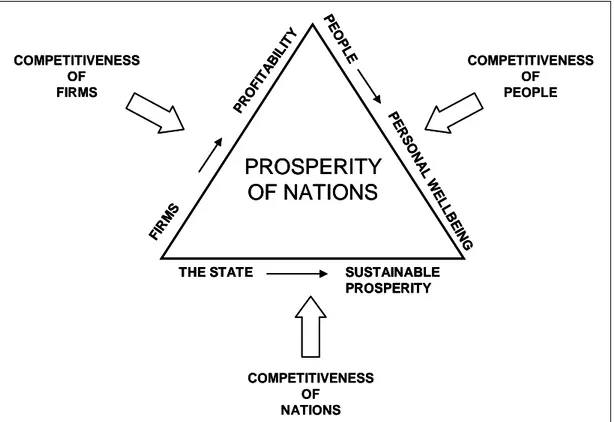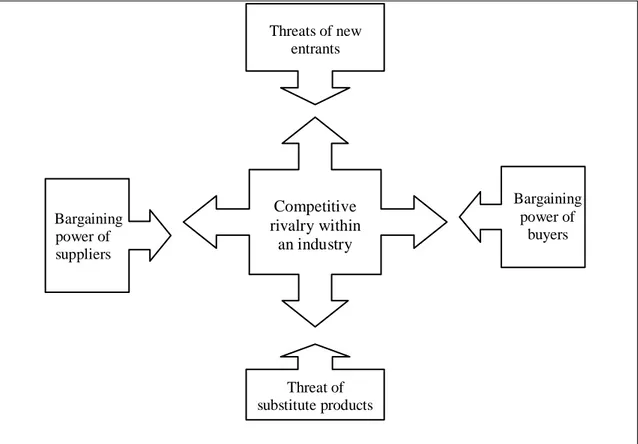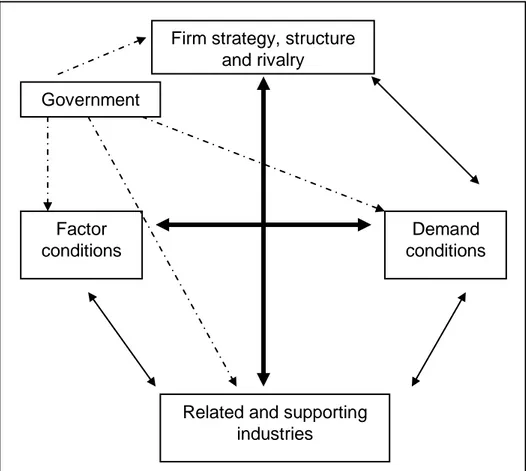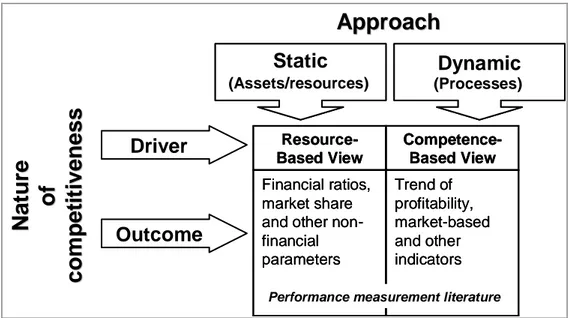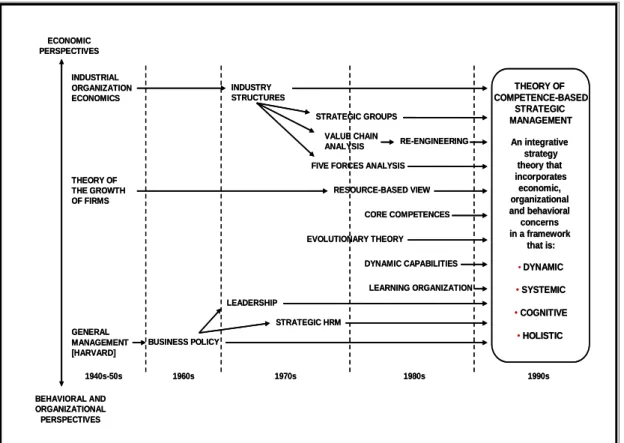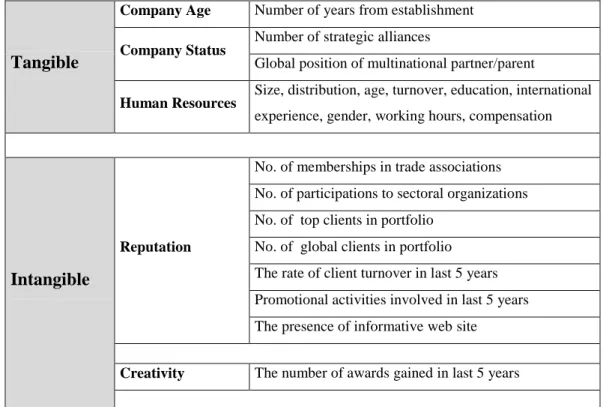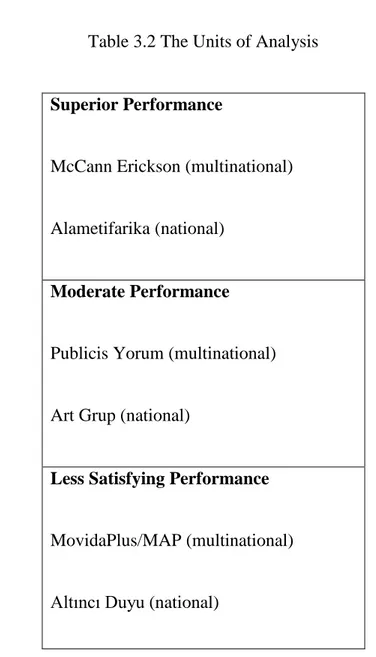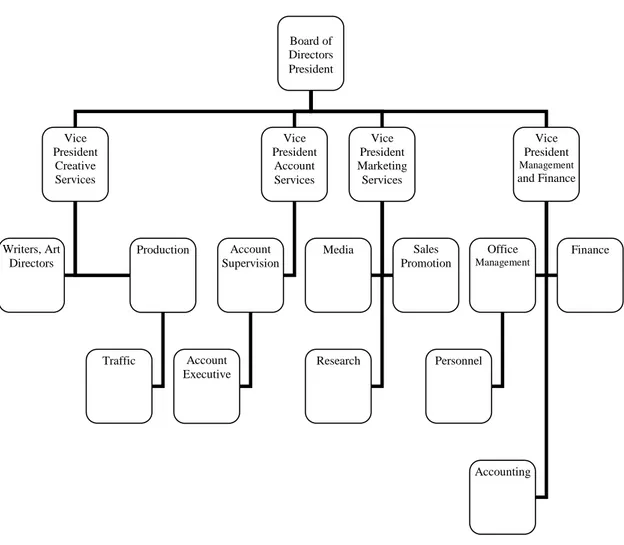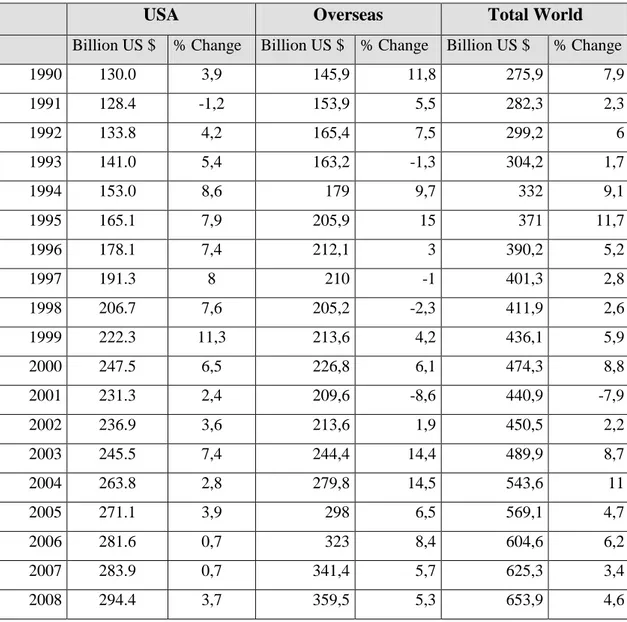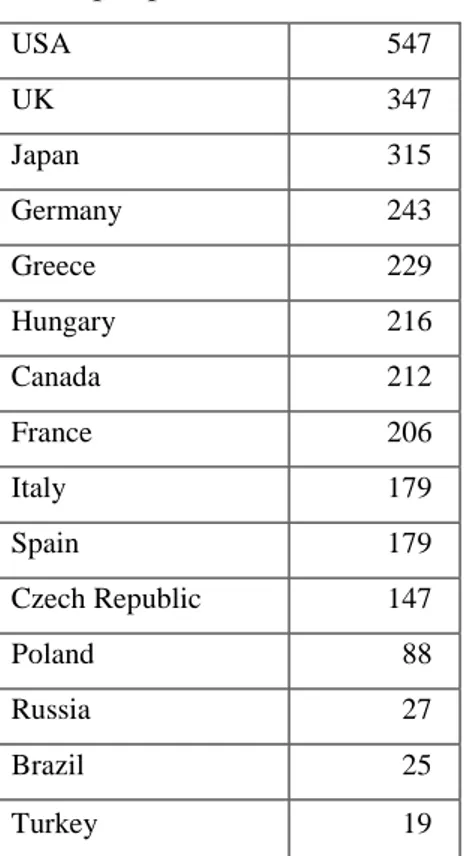COMPETITIVENESS OF PROFESSIONAL SERVICES: CASE
OF TURKISH ADVERTISING AGENCIES
ÇĠĞDEM ġAHĠN
IġIK UNIVERSITY 2008 Ç . ġ AH ĠN P h.D. The sis 2008COMPETITIVENESS OF PROFESSIONAL BUSINESS SERVICES:
CASE OF TURKISH ADVERTISING AGENCIES
ÇĠĞDEM ġAHĠN
B.A., Advertising and Public Relations, Anadolu University, 1991 M.A., Advertising, Marquette University, 1995
Submitted to the Graduate School of Social Sciences in partial fulfillment of the requirements for the degree of
Doctor of Philosophy in
Contemporary Studies in Management
IġIK UNIVERSITY 2008
ii
COMPETITIVENESS OF PROFESSIONAL SERVICES: CASE OF TURKISH ADVERTISING AGENCIES
Abstract
This study seeks to examine the extent to which internal factors affect the competitiveness of professional service firms. A case of Turkish advertising agencies is selected because of the advertising industry‟s highly knowledge and skill intensive characteristics and the increased competition among the firms in recent years. In addition to resources, organizational and managerial capabilities and the knowledge of the firms will be investigated to understand the degree of their effects on the process of their competitiveness. By conducting a case study methodology, a comparison among three multinational and three national agencies that have superior, moderate and less satisfying performances is used to explain the relationship between the sources of competitiveness and firm performance.
iii
PROFESYONEL HĠZMET SUNAN FĠRMALARIN REKABETÇĠLĠĞĠ: TÜRK REKLAM AJANSLARI ÖRNEĞĠ
Özet
Bu çalıĢma, profesyonel hizmet sektöründeki firmaların rekabetçiliğini etkileyen içsel faktörleri ortaya çıkarmayı hedeflemektedir. Firmaların sadece kaynakları değil, örgütsel ve yönetimsel becerileri ve bilgileri de incelenmekte ve bütünsel bir yaklaĢım içinde firmaların rekabetçiliğini etkileyen faktörler analiz edilmektedir. AraĢtırma, reklam sektöründeki firmalara odaklanmıĢtır. Reklam sektörünün bilgi ve yetenek yoğun bir sektör olması ve özellikle Türkiye‟deki reklam ajansları arasında son yıllarda artan bir rekabet yaĢanması bu sektörde verimli bir araĢtırma yapabilmeyi mümkün kılmaktadır. Üç uluslararası ve üç yerel olmak üzere seçilen altı örnek ajans ile yapılan örnek olay çalıĢmasıyla, profesyonel hizmet veren firmaların performanslarını etkileyen, rekabet avantajı yaratmaya yönelik faktörler incelenmektedir.
iv To my precious son, Balkar.
APPENDIX B
v
Acknowledgements
I would like to express my deepest and sincere gratitude to my major professor and thesis advisor Professor Hacer Ansal. In the last two and a half year when I was struggling with my thesis (the days of blood, sweat and tears!) she was always with me, and was motivating and inspiring. I feel very fortunate for studying under her supervision.
I am pleased to thank Professor Toker Dereli and Professor Cavide Uyargil who contributed much to the development of this research starting from the early stages of my dissertation work. They provided insightful suggestions and expertise. I also thank to all my professors at IĢık University who helped and guided me well during my long journey. I also thank Munise IĢık who was always considerate and helpful when I needed her assistance.
I would also like to thank to my colleagues at DoğuĢ University, School of Advanced Vocational Studies, who always supported me in the most stressful times of the dissertation process. First and foremost I would like to thank Gülsen Kahraman, the director of School of Advanced Vocational Studies at DoğuĢ University who patiently provided the vision, encouragement and advise necessary for me to complete my dissertation. My special thanks go to Yasemin Karagül and Mehmet Tolga Taner who advised me for the dissertation defense and helped me to make necessary corrections. I wish my best to them in their dissertation studies.
I would like to acknowledge my husband, Akın and our son, Balkar for their love, support and patience in the last 5 years. Nothing in a simple paragraph can express the love I have for both of them.
AP PE ND IX C
vi
Table of Contents
Abstract ii Özet iii Dedication iv Acknowledgements v Table of Contents viList of Tables viii List of Figures x
1 Introduction 1
2 Literature Review 4
2.1 The Concept of Competitiveness……….………... 4
2.1.1 Evolution of the Concept of Competitiveness ……….… 7
2.1.2 Measurement of Competitiveness ………...……….…… 9
2.2 Firm Level Competitiveness ………..… 13
2.2.1 The Concept of Competitive Advantage ………...… 13
2.2.2 Main Approaches of Internal Firm Level Analysis ………... 15
2.2.2.1 Resource-based View ……….………… 15
2.2.2.2 Competence-based or Capability-based View ……….. 19
2.2.2.3 Knowledge-based View ……….……… 25
2.3 Competitiveness in Professional Service Firms ..………..… 37
2.3.1 The Nature of Services and Professional Business Firms…………. 37
2.3.2 How Do Professional Business Services Generate Competitive Advantages? ………..………... 42 2.3.2.1 Knowledge ……….……….……… 42 2.3.2.2 Client Relations ………….……….……… 45 2.3.2.3 Human Capital ………….……….……….………… 47 2.3.2.4 Service Differentiation ……….………… 48 2.3.2.5 Management Ability ………..………….… 50
vii
2.3.2.6 Internationalization and Networking …….……… 52
2.4 Theoretical Framework ………...………….……….. 54
2.4.1 Research Questions ………..……... 55
2.4.2 Definition of Factors and Their Measures Used in the Study……… 56
2.4.2.1 Firm Resources ……….……….……….. 57 2.4.2.2 Firm Capabilities ……….…………..….. 60 2.4.2.3 Firm Knowledge ……….………..……….. 64 3 Methodology 67 3.1 Research Design ……….……….…. 67 3.1.1 Units of Analysis ………..…………..…... 68 4 Advertising Services 72 4.1 The Nature of Advertising Services .…..……….………. 72
4.2 Advertising Market in the World ……….. 76
4.3 Advertising Market in Turkey …….……….. 81
5 Case Studies 86 5.1 Case 1: MovidaPlus/MAP ………….…..……….………. 86 5.1.1 Background ………..………….. 86 5.1.2 Firm Resources ………..……….. 87 5.1.2.1 Tangible Resources ………..………. 87 5.1.2.2 Intangible Resources ……….………. 89
5.1.3 The Firm‟s Capabilities ………..……….. 90
5.1.3.1 Organizational Capabilities ……….……….…. 90
5.1.3.2 Managerial Capabilities ………….………. 93
5.1.4 Firm's Knowledge ………...……... 94
5.2 Case 2: Altıncı Duyu …………..……….. 96
5.2.1 Background ………..……... 96
5.2.2 The Firm‟s Resources ………... 97
5.2.2.1 Tangible Resources ………..…….…………. 97
5.2.2.2 Intangible Resources …….……….………..……. 97
5.2.3 The Firm‟s Capabilities ………..………... 98
5.2.3.1 Organizational Capabilities ……….………...…. 99
5.2.3.2 Managerial Capabilities ……..….………..…. 103
5.2.4 Firm's Knowledge ……….... 105
viii
5.3.1 Background ………...……... 106
5.3.2 The Firm‟s Resources ………... 108
5.3.2.1 Tangible Resources …….………...………. 108
5.3.2.2 Intangible Resources ………..…….……….…. 109
5.3.3 The Firm‟s Capabilities ………..……... 110
5.3.3.1 Organizational Capabilities ……….………. 110
5.3.3.2 Managerial Capabilities ……..….………. 114
5.3.4 Firm's Knowledge ………...……... 116
5.4 Case 4: Art Grup ………….…..………. 117
5.4.1 Background ………..……….... 117
5.4.2 The Firm‟s Resources ………..……... 118
5.4.2.1 Tangible Resources …….……….………. 118
5.4.2.2 Intangible Resources …….……….……… 119
5.4.3 The Firm‟s Capabilities ………..…..……... 120
5.4.3.1 Organizational Capabilities ……….………..…. 120
5.4.3.2 Managerial Capabilities ………….………. 124
5.4.4 Firm's Knowledge …………..………...……... 126
5.5 Case 5: McCann Erickson ...…..………. 127
5.5.1 Background ………..………. 127
5.5.2 The Firm‟s Resources ………..……….... 128
5.5.2.1 Tangible Resources ………..……. 128
5.5.2.2 Intangible Resources …….……….………. 131
5.5.3 The Firm‟s Capabilities ………... 132
5.5.3.1 Organizational Capabilities ………..………. 132
5.5.3.2 Managerial Capabilities ……..………. 135
5.5.4 Firm's Knowledge ……….………... 138
5.6 Case 6: Alametifarika …...…..………….………...………. 139
5.6.1 Background ………..………... 139
5.6.2 The Firm‟s Resources ………..………... 140
5.6.2.1 Tangible Resources …….……….………. 140
5.6.2.2 Intangible Resources ………. 142
5.6.3 The Firm‟s Capabilities ………..……... 144
5.6.3.1 Organizational Capabilities ……….……….……. 144
ix
5.6.4 Firm's Knowledge ………..………... 153
6 Analysis of Case Studies 155 6.1 Analysis of Firm Resources …….……….…. 155
6.1.1 Tangible Resources ………..………..…... 155 6.1.1.1 Company Age ……….…. 155 6.1.1.2 Company Status ……….……….……. 156 6.1.1.3 Human Resources ………..………. 156 6.1.2 Intangible Resources ………..……... 161 6.1.2.1 Reputation ……….………….…..………. 161 6.1.2.1 Creativity ………..…..……….……… 162
6.2 Analysis of Firm Capabilities …….…..………. 165
6.2.1 Organizational Capabilities ………... 165
6.2.1.1 Employee Involvement …….……….…. 165
6.2.1.2 Service Quality ……….……….…. 167
6.2.1.3 Organizational Structure ……….………….…. 170
6.2.2 Managerial Capabilities ……….………... 175
6.2.2.1 Top Manager‟s Status and Credibility .… ………. 175
6.2.2.2 Managerial Knowledge ……….………….…. 176
6.2.2.3 Managerial Strategy ….……….………. 179
6.3 Analysis of Firm Knowledge …….…..………..…. 182
7 Findings and Conclusions 186 7.1 Results ……….….…..……….………. 186
7.2 Conclusions ……….….…..………. 194
7.3 Limitations ……….….…..………..………..…. 197
7.4 Implications ………….….…..……….………. 198
7.4.1 Implications for Future Research ………... 198
7.4.2 Implications for Managers ……….………..…...…... 199
References 201 Vita 214
x
List of Tables
Table 2.1. Firm assets... 17
Table 2.2 Definition of central terms ... 23
Table 2.4 The factors and their components ... 57
Table 2.5 Firm resources: tangible and intangible factors and their measures ... 59
Table 2.6 Firm capabilities: the organizational and managerial factors ... 63
Table 2.7 The factors and their measures... 64
Table 3.1 Top advertising agencies of 2006 ... 69
Table 3.2 The units of analysis ... 70
Table 4.1 Worldwide ad growth: 1990-2008 ... 78
Table 4.2 World‟s top 10 marketing organizations ranked by worldwide revenue ... 79
Table 4.3 Top 10 core agencies worldwide ... 80
Table 4.4 Comparison of the major countries on advertising expenditure ... 82
Table 4.5 Distribution of advertising expenditures in media in turkey ... 83
Table 4.6 The parent companies/networks and their agencies in turkey ... 84
AP PE ND IX C APPENDIX B
xi
Table 4.7 Top advertising agencies of 2006 ... 85
Table 5.1 MovidaPlus/Map‟s employee structure ... 88
Table 5.2 Employee's educational status ... 88
Table 5.3 Altıncı Duyu‟s employee structure ... 97
Table 5.4 Altıncı Duyu‟s educational status ... 98
Table 5.5 Employment structure in Publicis Yorum ... 108
Table 5.6 The educational status of Publicis Yorum‟s employees ... 109
Table 5.7 Art Grup‟s employee structure ... 118
Table 5.8 Employees‟ educational status ... 119
Table 5.9 Employee structure in McCann Erickson ... 130
Table 5.10 Education levels of employees in McCann Erickson... 130
Table 5.11 Alametifarika‟s employee structure ... 141
Table 5.12 Employee‟s educational status in Alametifarika ... 141
Table 6.1 Comparison of human resources factors of the multinational agencies .. 157
Table 6.2 Comparison of human resources factors of the national agencies ... 158
Table 6.3 Summary of results 1: Tangible resources ... 160
xii
Table 6.5 Intangible resources of the national agencies ... 163
Table 6.6 Summary of results 2: Intangible resources ... 164
Table 6.7 Employee involvement methods of the multinational agencies ... 166
Table 6.8 Employee involvement methods of the national agencies ... 167
Table 6.9 Determinants of service quality in the multinational agencies ... 168
Table 6.10 Determinants of service quality in the national agencies ... 170
Table 6.11 Organizational structures of the multinational agencies ... 171
Table 6.12 Organizational structures of the national agencies ... 173
Table 6.13 Summary of results 3: Organizational capabilities ... 174
Table 6.14 The status and credibility of the top managers of the multinational agencies ... 175
Table 6.15 The status and credibility of the top managers of the national agencies 176 Table 6.16 Managerial knowledge at the multinational agencies ... 177
Table 6.17 Managerial knowledge at the national agencies ... 178
Table 6.18 Managerial strategies of the multinational agencies ... 180
Table 6.19 Managerial strategies of the national agencies ... 181
xiii
Table 6.21 Knowledge accumulation in multinational agencies ... 183
Table 6.22 Knowledge accumulation in national agencies ... 184
Table 6.23 Summary of results 5: Firm knowledge ... 185
Table 7.1 Tangible and intangible factors affecting the competitiveness of the
advertising agencies ... 189
Table 7.2 Organizational and managerial factors affecting the competitiveness of the advertising agencies ... 192
Table 7.3 Knowledge-related factors affecting the competitiveness of the
xiv
List of Figures
Figure 2.1 Competitiveness drives prosperity ... 6
Figure 2.2 The five competitive forces that determine industry profitability ... 10
Figure 2.3 Diamond model for competitiveness of nations ... 11
Figure 2.4 Analysis of competitiveness at firm level ... 15
Figure 2.5 Overview of strategic management ... 20
Figure 2.6 Sources of firm competitiveness ... 25
Figure 2.7 The alliance knowledge acquisition process ... 36
Figure 2.8 Integrating strategic variables within causal framework of reputation .... 49
Figure 2.9 An integrated approach for competitiveness ... 55
Figure 4.1 A typical full-service agency organization ... 74
AP PE ND IX C APPENDIX B
1
Chapter 1
Introduction
The aim of this study is to explore the internal factors affecting the competitiveness of firms in professional service industry. Although there is a vast amount of literature examining the competitiveness and internationalization of manufacturing firms, little research has been conducted to examine service competitiveness, particularly competitiveness of professional services (Ochel, 2002; Hitt et al., 2006). However, today‟s economy has been mainly driven by service industries and professional firms (Fernandez, 2001). Services are also becoming highly internationalized due to rapidly growing service industries in advanced nations, development of new types of services as a result of technological advancements (such as information technologies), and the emergence of new type of large and sophisticated service companies (such as Google) (Kotler, 2003). The intellectual capital is the main driver of this new economy which is often described as weightless, human oriented and knowledge intensive.
Service industries comprise nearly 90% of the U.S. economy which is seen as the largest economy in the world (The Wall Street Journal, 2007). According to the Coalition of Service Industries (CSI) (2008) which is a leading organization of the U.S. service sector, services jobs reached nearly 80.2% of the U.S. private sector employment in 2006. It is stated that services added 15 million new U.S. jobs between 1996 and 2006. It is expected that 90% of all new jobs until 2012 will be created by new services.
The service sector currently includes some of the most intensive international competition. Especially the professional services provided by architects and engineers, computer firms, law partnerships, accountants and business consultants, advertising agents, etc. have been largely internationalized and exceed their home-country borders (Nachum, 1996). Hitt et al. (2006) evaluate the growth and internationalization of professional services as “the most profound business phenomenon of the 20th century”
2
(p.1137). Therefore, there is a need for redefining the sources of competitiveness in the light of services and professional business services in particular. Moreover, as pointed out by the previous studies (Garelli, 2006), there is a need for focusing on more intangible variables; such as reputation, knowledge, creativity, client relationship, etc. in the so-called this intangible economy since these factors become as important as those hard figures we have used to see in manufacturing studies; like market share, productivity, profits, etc (Porter, 2000; Depperu and Cerrato, 2005).
By using a holistic approach that analyzes resources, capabilities and knowledge of firms at the same time, this study conducts a qualitative research in a single professional business sector, namely advertising sector where tacit knowledge and intangible variables are more important. Like many other professional business services, knowledge is the core resource for advertising sector; as both input and output. The advertising agencies operating in Turkey are investigated because of the accelerated growth of the advertising sector in Turkey and its highly competitive structure due to the dominance of the multinational firms in the recent years. The research seeks to find out what the factors of competitiveness for advertising agencies are and how they change in national and multinational levels.
Chapter 2 examines one of the controversial concept; competitiveness in detail. The problems related with its nature and its measurement are discussed. But more specifically, this chapter involves with firm-level studies of competitiveness. The nature of services and professional service industry and their competitiveness constitute the large part of the chapter and are presented comprehensively. At last, Chapter 2 introduces the theoretical frame of this study and explains the factors and their measurements used in the research.
Chapter 3 covers the methodology of the research. It explains the research method; case study, and its rationale. In addition, the units of analysis are introduced and research protocol is presented. Chapter 4 focuses on advertising sector and presents the basic characteristics of advertising business and the development of international advertising business. Local and international structures of advertising business are discussed in two separate sections. Chapter 5 presents the each case study
3
consecutively. Each case has background information prior to their stories to provide the readers to get a deeper understanding about the each case.
Chapter 6 covers the detail analysis and comparisons about the cases. The results and the final conclusions are submitted at Chapter 7. Like all studies, this study has some limitations and they are discussed at this chapter. At last, important implications for further research and for professional managers are also presented.
4
Chapter 2
Literature Review
This study entails a broad analysis of the studies in the fields of strategic management, economics and organizational management to examine competitiveness in a professional service industry. Hence, competitiveness as a multidimensional concept will be examined first, and then firm level competitiveness and the related theories will be discussed. Since the main focus of the study is professional business service firms and advertising agencies in particular, the nature of professional services, their process of generating competitive advantages, and the related studies about professional services and advertising sector from the competitiveness perspective will be investigated in more detail.
2.1 The Concept of Competitiveness
Competitiveness is one of the most popular and controversial terms in modern economics. The term was derived from the Latin verb “competere” which means to make every effort for something in rivalry (Garelli, 2006). By the effects of free trade and globalization of goods, services, people, skills, and ideas, competitiveness has become synonymous with economic strength of an entity (Murths, 1998).
Competitiveness is in principle a firm level concept (Garelli, 2006). However, it is often evaluated at the national level by looking at a country‟s international performance depending on its firms‟ international market share, export shares, international profitability and achievement of economic growth in the long run (Yap, 2004). As Porter (1990) argues, a nation‟s standard of living is increasingly dependent on the competitiveness of its firms. Competitiveness is vital if the nation‟s firms are to
5
take advantage of the opportunities opened up in the international arena. Especially for small nations, competitiveness can allow firms to overcome the limitations of their small home markets and achieve their maximum potential (Zahra, 1999). Competitiveness is also unavoidable if a nation‟s firms are to guard against the threats posed by the international economy (Buckley, Pass, and Prescott, 1990). The lower costs for transportation, and the use of information technologies which increase speed and communication have accelerated international competition and it has become fiercer than ever before (Garelli, 2006).
The main goal of competitiveness is to increase overall level of prosperity of a nation, by increasing profitability of its firms and enhancing well-beings of its citizens (Garelli, 2006). Although the term is widely known, there is little consensus among the scholars about its definition. For some, it is a dangerous obsession or “a poetic way of saying productivity” (Krugman, 1994) and for some; it is synonymous with a firm‟s long–run profit performance (Buckley et al., 1990). Almost all definitions given for competitiveness (IMD Yearbook, 2005) interpret the concept as an output of firm‟s activities and focus on its elements of productivity, efficiency and profitability. However, competitiveness also includes some important qualitative considerations such as knowledge, brand image, human skills, value systems, etc. which have certain effects on the performances of firms (Garelli, 2006). Therefore, competitiveness is much more a wider concept to be evaluated only as an output or a result measured by some quantifiable measures such as growth rate or productivity (Teece, et al., 1997).
In their detail analysis of the literature, Ambastha and Momaya (2004) also conclude that the major reason for the debate on competitiveness is the lack of understanding its multifaceted characteristics. Garelli (2006) also stresses the importance of evaluating competitiveness as a multifaceted concept which includes hard, quantifiable economic issues such as growth rates, but also some qualitative, softer issues such as impact of education and value systems.
Recent studies on this area (Barney, 2001; Ambastha and Momaya, 2004; Garelli, 2006; Lowendahl, 2000). suggest using a holistic approach that covers the assets, resources as well as abilities, skills, and potentials to define the competitiveness. According to Garelli (2006, p.3), “Competitiveness is the ability of a nation,
6
company or individual to manage the totality of competencies to attain prosperity or profit” The phrase of “managing the totality of competencies” implies that being
competitive is related with what we have got inside as a nation, a company or a person. Thus, the recent definition suggests attaining an inside-out approach rather than outside-in approach as used in previous studies (i.e., Porter, 1990). Garelli (2006) asserts that this definition combines all the drivers of prosperity and brings a holistic view to analyze competitiveness. While nations (governments) support their firms to generate economic added value by creating appropriate structures, they are also responsible from transforming the results of firms‟ activities into valuable tools for prosperity of people. Figure 2.1 illustrates the interaction of these three drivers of prosperity included in the definition.
COMPETITIVENESS OF NATIONS
PROSPERITY
OF NATIONS
FIR MS PROF ITA BIL ITYTHE STATE SUSTAINABLE PROSPERITY P E OP L E P E RS ON A L WE L L BE ING COMPETITIVENESS OF PEOPLE COMPETITIVENESS OF FIRMS COMPETITIVENESS OF NATIONS
PROSPERITY
OF NATIONS
FIR MS PROF ITA BIL ITYTHE STATE SUSTAINABLE PROSPERITY P E OP L E P E RS ON A L WE L L BE ING
PROSPERITY
OF NATIONS
FIR MS PROF ITA BIL ITYTHE STATE SUSTAINABLE PROSPERITY P E OP L E P E RS ON A L WE L L BE ING COMPETITIVENESS OF PEOPLE COMPETITIVENESS OF FIRMS
Figure 2.1 Competitiveness Drives Prosperity Source: Garelli, 2006, p.xiv
7
2.1.1 Evolution of the Concept of Competitiveness
Competitiveness is relatively a modern term; it has been regarded as a field of economics only since the 1980s (Garelli, 2006). However, since Adam Smith and classical trade theories, there have been many important contributions that provide the ground work for the development of the competitiveness concept (Cho and Moon, 2000). These studies can be grouped into three approaches: Traditional trade theory,
Industrial organization theory and Strategic management theory (Ambastha and
Momaya, 2004).
Traditional trade theories, especially the law of comparative advantage provides useful insights into the development of the competitiveness (Garelli, 2006). This theory asserts that economic welfare is dependent on the production of goods and services that a country (or a firm) has comparative advantage in (Cho and Moon, 2000). The theory implies that a nation or a firm should not focus on the activities it can perform better or cheaper than its competitors, rather on those where its relative advantage is larger (Metcalfe, 1999). The theory advocates that competitiveness or comparative advantage is mainly determined by factor endowments, increased savings and investments, innovations in products and production processes, and intensity of entrepreneurial activity (Cho and Moon, 2000). Thus, the traditional theories contribute that specialization in products, accumulation of resources, improvement and innovation in production processes, and entrepreneurship skills are key drivers of competitiveness (Garelli, 2006).
Since the traditional trade theories of competitiveness are mainly involved in issues related with production and creating efficiency, they were insufficient to address the qualitative differences in products, marketing and service abilities of firms and the strategies by which industries attain competitiveness (Peterson and Barras, 1987) Because trade models failed to address such issues, an additional school of thought has come into the ground and combined both the supply and demand perspectives of competitiveness (Hermann, 2005).
Contrary to the traditional trade theories, the Industrial Organization (IO) Theory focuses on the effects of industry-related determinants on firm performance and
8
identification of variables like concentration, entry and exit barriers and economies of scale that influence economic performance (Peltzman, 1991). The industrial organization economics which is known mainly by the approach of
Structure-Conduct-Performance treats the firm as a collection of product-market choices and activities, whose position in the industry and the industry's structure determine its conduct (strategy) and performance. Classical industrial organization scholars (i.e., Chamberlain and Mason, can be found at Corley, 1990) claim that a firm can neither influence industry conditions nor its own performance. Industry or market structure determines member firms‟ conduct and performance. Therefore, the competitive advantage originates from external sources rather than internal (firm-specific) sources (Peltzman, 1991)
A modified framework has been advanced by the new industrial organization scholars (i.e., Chandler, Williamson, Hymer, etc. can be found at Corley, 1990) which recognize that firms have a certain influence on the relationship between industry structure and a firm's performance. According to Porter (1998), evolution of an industry is affected by its firms‟ strategic choices. Thus, competitiveness can be defined as the ability to profitably create and deliver value through cost leadership and or product differentiation. This definition implies that competitiveness is directly related to factors that influence both the cost and demand structure of a firm (Porter, 1979).
Furthermore, the Strategic Management School of thought can be seen as a theory of competitiveness which brings together the concepts of both trade theory and IO (Herrmann, 2005). Strategic management scholars emphasize the importance of firm‟s specific resources in determining performance differences among firms. According to their approach, a firm has a certain influence on its industry structure (Depperu and Cerrato, 2005).
The main studies in the field of strategic management fall into three categories: The resource-based view, the competence-based view, and the knowledge based view. These studies reveal that firms can gain competitive advantage through the accumulation, improvement, and redefinition of its unique resources, capabilities, and
9
knowledge (Depperu and Cerrato, 2005). In the section 2.2 these three approaches will be investigated in more detail.
2.1.2 Measurement of Competitiveness
The concept of competitiveness has been analyzed at three levels: industry level, national level and firm level (Ambastha and Momaya, 2004). The competitiveness of an industry is analyzed by making comparison with the same industry in another region or country. The measures of competitiveness at the industry level include the firms' profitability, the industry's trade balance, and the balance of outbound and inbound foreign direct investment (McFetridge, 1995).
Porter states (1998) that the firm performance is dependent on the industry structure. According to him, in any industry, whether it is domestic or international or produces a product or a service, there are five forces determine the industry profitability because they influence the price, cost, and the required investment of the firms in an industry. These competitive forces are the entry of new competitors, the threat of substitutes, the bargaining power of buyers, the bargaining power of suppliers, and the rivalry among the existing competitors. A change in any of the forces normally requires a company to re-assess the marketplace. Porter (1998) defines competitiveness at organizational level as productivity growth that is reflected in either lower costs or differentiated products that command price premium. Figure 2.2 illustrates the five forces model of an industry.
10 Competitive rivalry within an industry Bargaining power of suppliers Bargaining power of buyers Threat of substitute products Threats of new entrants
Figure 2.2 The Five Competitive Forces That Determine Industry Profitability Source: Porter, 1998, p. 23
National competitiveness is also a wide research area especially developed parallel to the globalization movement. One of the most popular theories of national competitiveness was generated by Porter (1990). The so-called diamond model disputes with the traditional trade theories which sees the factor endowments as the main indicator of a nation‟s wealth. Porter (1990) argues that national prosperity is not inherited, but created by choices; in other words, national wealth is not set by factor endowments, but created by making strategic choices. He showed different choices of creating wealth, which had been quite limited in the world of traditional trade theories.
In his diamond model (1990), Porter stresses that competitiveness involves more than just macroeconomic issues such as deficit, interest rate, and political stability. While macroeconomic issues are necessary though not sufficient, the long-term determinants of productivity are rooted in the microeconomic conditions in the economy such as human capital, research and development capacity, physical infrastructure, and
11
innovation capacity. According to Porter (1990), the determinants of the national competitive advantage are grouped in four categories: Factor conditions, demand conditions, related and supporting industries, and firm's strategy, structure and rivalry. Porter (1990) shows that nations gain competitive advantage in industries where the buyers put pressure on companies to innovate in order to achieve competitive advantage. A nation‟s success depends largely on the types of education its people choose and the type of work. Moreover, the presence of domestic rivalry is an essential motive for the creation and the sustainability of competitive advantage. The related and supporting industries provide close working relationships whereby suppliers and users are located in proximity of each other that take an advantage of short lines of communication, quick and constant flow of information, and ongoing exchange of ideas and innovations. Figure 2.3 demonstrates the Diamond Model of Porter. Factor conditions Demand conditions Government
Firm strategy, structure and rivalry
Related and supporting industries
Figure 2.3 Diamond Model for Competitiveness of Nations Source: Porter, 1990, p. 73.
12
Garelli (2006) gives examples from several countries showing that natural resources do not necessarily lead to competitiveness. For example, Brazil, Indonesia, and India are rich nations in terms of their natural resources, but they have not transformed these resources into competitive advantages to increase their competitiveness. On the other hand, some poorer nations in terms of natural resources, like Singapore, Japan, and Switzerland are highly competitive nations since they have been able to transform imported natural resources into manufactured products (Garelli, 2006). Therefore, wealth cannot be an indicator of future competitiveness since it cannot provide any guarantee that today‟s prosperity will continue on tomorrow. Basically, the concept of competitiveness stresses the importance of long term sustainability, and benchmarking the performance with the present competitors instead of making individual past performance comparisons. Competitiveness also requires firms to be ambitious about achieving maximizing competitive advantages instead of being satisfied with the present situation (Buckley, et al.,1990).
Firm level studies focuses on behaviors and performances of firms. Firm level competitiveness indicates a firm‟s ability to design, produce and market products superior to those offered by its rivals where superiority can be defined by several factors, like price, quality, technological improvement, etc. (Porter, 1990; Thompson and Strickland, 1999). The following section explores the studies of firm-level analysis of competitiveness in detail. Before move on, it is important to underline the problems in the measurement of competitiveness. Because of the multidimensional characteristics of the concept, the measurement is also complex in its nature. The factors affecting such construct may have different weights which generally vary from firm to firm as well as from industry to industry (Garelli, 2006).
Because of its time-based characteristics, there is an inherent failure of measurements arising from the use of past performance indicators to assess the present competitiveness. Moreover, a single period of measurement cannot reflect all the indicators of competitiveness. In the case of diversified firms, business level competitiveness and corporate level competitiveness may also vary (Garelli, 2006; Ambastha and Momaya, 2004). In addition, some intangible sources create methodological challenges. Many intangible resources are measured by using archival
13
proxies, such as measuring creativity with the awards gained (Barney, 1991). Some scholars (Rouse and Daellenbach, 1999; Barney, 2001) suggest using qualitative methods to overcome such limitations and to provide a broad explanation to measurements. Therefore, it should be taken into account when making an analysis about competitiveness that there will be some limitations due to the nature of the concept and academic definitions given for each levels of competitiveness could not reflect all the factors affecting the process of competitiveness at practice (Ambastha and Momaya, 2004).
2.2. Firm Level Competitiveness
There are two levels of analysis at firm level, as internal and external firm level analyses (Depperu and Cerrato, 2005). This dissertation focuses on internal firm level analysis; and deals with resources, abilities, processes, knowledge embodied in the firm, thus main focus here will be on identifying internal factors affecting the competitiveness at firm level. The main approaches of internal firm level competitiveness will be elaborated and recent developments will be discussed further.
2.2.1 The Concept of Competitive Advantage
Competitive advantage is a fundamental concept in firm level studies. It is widely seen as a core element of a firm's competitive process. Porter (1998) who initially developed seminal works in this field defines that a firm's performance is affected by its competitive advantage. Competitive advantage is described as the degree of superiority allowing one firm to compete better than its rivals (Porter, 1979). D‟Cruz (1992) defines firm-level competitiveness as the ability of firm to design, produce and/or market products superior to those offered by competitors, considering the price and non-price qualities.
The analysis of the sources of variance in firm performance is a key issue in both industrial organization and strategic management studies. From an empirical point of view, research about the influence of firm and industry effects on performance shows that a relevant percentage of the variance in profitability is strongly attributed to firm-level variables (McGahan, 1999).
14
There are internal and external sources of competitiveness at firm level (Depperu and Cerrato, 2005). In the classical industrial organization studies, the competitive advantage is seen as dependent upon external sources rather than internal (firm-specific) sources (Peltzman, 1991). The classical organization theory states that so-called “above-industry performance” should emerge from the positioning of a company within an industry, which in turn is primarily determined by the strategy adopted by the company (Caves and Ghemavat, 1992).
According to industrial organization scholars, external sources of competitive advantage are those occur without the firm‟s characteristics that affect firm‟s competitive advantages, such as industry structure, macroeconomic policies, regulatory policies, environmental and social events, etc. (Porter, 1990; Lieberman, and Montgomery 1998; Caves and Ghemavat, 1992). As seen in the Five Forces Model; external sources of competitiveness are related with the variables such as strong rivalry among existing firms in the industry; weak bargaining power of suppliers, etc.
Internal sources are those that depend upon the firm‟s own resources, assets and organizational capabilities and structure (Barney, 1991; Depperu and Cerrato, 2005). The studies of strategic management scholars focus on the importance of firm specific resources in determining performance differences among firms in an industry. The main approaches in strategic management school fall into three categories; Resource-based view (Penrose, 1959; Wernerfelt, 1984; Barney, 1991; Peteraf, 1993; and 1994; Mahoney, 1995, etc.), Competence or Capability- based view (Pralahad and Hamel, 1990; Collis, 1994; Eisenhardt and Martin, 2000; Teece, et al., 1997; etc.), and Knowledge-based view (Grant, 1996; Inkpen, 1998; Kaplan, et al., 2001). According to those scholars, a firm‟s unique resources, capabilities and knowledge generate its competitive advantage (Depperu and Cerrato, 2005) that has an influence on the industry structure.
Competitiveness at firm level can be treated as dependent or independent variable depending on the perspective of a study. When competitiveness is seen as a dependent variable which is affected by the combination of assets and processes of a firm, it is
15
seen as a driver of the firm‟s performance. Thus, competitiveness is also evaluated as a process. On the other hand, when it is considered as an independent variable, it is seen as the outcome of a firm‟s competitive advantages, thus it is also appraised as a proxy for a firm‟s performance (Depperu and Cerrato, 2005; Ambastha and Momaya, 2004). Figure 2.4 illustrates the analysis of competitiveness at firm level.
Financial ratios, market share and other non-financial parameters Trend of profitability, market-based and other indicators Resource-Based View Competence-Based View
Performance measurement literature
Financial ratios, market share and other non-financial parameters Trend of profitability, market-based and other indicators Resource-Based View Competence-Based View
Performance measurement literature
Approach
Approach
Driver
Outcome
(Assets/resources)Static
(Assets/resources)Static
Dynamic
(Processes)Dynamic
(Processes)N
at
u
re
N
at
u
re
o
f
o
f
co
m
p
et
co
m
p
et
ii
tt
ii
ve
n
es
s
ve
n
es
s
Figure 2.4 Analysis of Competitiveness at Firm Level Source: Depperu and Cerrato, 2005.
2.2.2 The Main Approaches of Internal Firm Level Analysis
In the following part, each of the three main approaches will be examined and compared in terms of competitiveness perspective.
2.2.2.1 Resource-based View
The resource-based view rests on the idea that firms create sustainable competitive advantages by developing and applying idiosyncratic firm resources (Barney, 1991). Wernerfelt (1984) broadly defines a resource as anything that could be defined as a strength or weakness of a given firm. More specifically, resource based view covers
16
core human and nonhuman assets, both tangible and intangible, that allow a firm to perform better than rival firms over a sustained period of time (Wernerfelt, 1984). The roots of the resource-based view (RBV) can be found in the work of Penrose (1959) which emphasizes how resources contribute to diversification and how diversification must match the "core competencies" of the firm for optimal performance. The Wernerfelt (1984) and Barney (1991)‟s articles are seminal works in the RBV stream. While Wernerfelt follows the path of Penrose by focusing on the role of resources and diversification in firm expansion to new products and markets, Barney (1991) provides a detailed framework to define the resources that can contribute to a sustainable competitive advantage. His study has supplied the footing for many RBV studies, with subsequent work based on either his framework or an extension (Godfrey and Gregersen, 1999).
Barney (1991) indicates that two assumptions are elemental to the RBV: (1) resources are distributed heterogeneously across firms, and (2) these productive resources cannot be transferred from firm to firm without cost (i.e., resources are "sticky"). These assumptions are the axioms of the RBV. Given the assumptions, Barney (1991) makes two fundamental arguments. First, resources that are both valuable (i.e., contribute to firm efficiency or effectiveness) and rare (i.e., not widely held) and can produce competitive advantage. Second, when such resources are also simultaneously not
imitable (i.e., they cannot easily be replicated by competitors), not substitutable (i.e.,
other resources cannot fulfill the same function), and not transferable (i.e., they cannot be purchased in resource markets; those resources may produce a competitive advantage that is long lived (sustainable). Thus, value and rarity are each necessary but not sufficient conditions for competitive advantage, whereas nonimitability, nonsubstitutability, and no transferability are each necessary but not sufficient conditions for sustainability of an existing competitive advantage. This model of RBV, known as WRIN (Valuable, Rare, Inimitable and No substitutable) has been acknowledged as the basis to understand RBV studies (Fahy and Smithee, 1999).
According to resource based view, the sources of competitiveness are those tangible and intangible resources. Tangible resources are in-put based resources, like plant, equipment, capital, human resources, etc., and intangible resources are generally out-put based resources, like reout-putation, creativity, and brand name (Barney, 1991,
17
Peteraf, 1993). According to Wernerfelt (1984), resources include brand names, in-house knowledge of technology, recruiting of skilled personnel, trade contacts, machinery, efficient procedures and capital. Barney (1991) adds firm attributes, information and knowledge to the list of Wernerfelt. In fact, Barney (1991) categorizes all kinds of resources into three main categories: Physical, human and organizational capital. E.g. physical: machines or plants, human: proprietary know-how, and organizational capital: reputation of the firm. Sanchez (2002) illustrates the main assets/resources defined by Barney in Table 2.1
Table 2.1 Firm Assets
Tangible assets Intangible assets
Physical Financial Human Technological Reputation Characteristics Production facilities Location Production flexibility Capacity surpluses Property and equipment Receivables from clients Cash and cash equivalents Liabilities Equity Knowledge and expertise Adaptability Loyalty Availability Performance Patents, copyright company secrets R&D facilities Qualifications of employees Brands Corporate image Corporate identity Relationship with suppliers Customer satisfaction Source: Sanchez, 2002, p. 522.
Intangible resources are widely seen as the primary source of competitive advantage. The tacitnesss of intangible input or skill based competencies would increase the difficulty of competitor imitation (Lado, et al., 1992). However, intangible resources are particularly difficult to measure (Barney, 1991). Some scholars have used variables such as R&D intensity, advertising intensity and patents to substitute intangible resources. Others have attempted to measure important resources such as human capital and reputation, for example, human capital leverage as a proxy for employees‟ skills. Although researchers are also using case studies, both multi-industry and single multi-industry case studies offer measurement difficulties.
18
Operationalization is complex in multi-industry studies because resources should be specific to industries and to individual firms. In contrast, although single industry studies allow using tests that help identify the resources critical to certain industries, there are limitations to the generalizability of the single study findings (Wernerfelt, 1995; Barney, 2001).
RBV has often been criticized in several aspects. Priem and Butler (2001) state that the RBV theory is self-verifying since takes “valuable” resources to be used in the process of “value-creation”, thus, it includes an operationalization problem. It is found difficult to find a resource which satisfies all of the Barney's VRIN criteria. Besides, different resource configurations can generate the same value for, firms and thus would not be competitive advantage (Conner, 1991; Hoopes, Madsen and Walker, 2003).
The role of product markets and external environment is underdeveloped in the argument, thus the theory has been found limited in prescriptive implications. RBV also fails to provide long-term implications. Lippman and Rumelt (1982) notes that prominent source of sustainable competitive advantages is causal ambiguity. However, it can cause a difficult situation: The firm is not able to manage a resource it does not know exists, even if a changing environment requires this. Through such an external change the initial sustainable competitive advantage could be nullified or even transformed into a weakness (Peteraf, 1993).
Regardless of the limitations in measuring resources, some studies that have empirically tested the original postulates of the RBV have confirmed the importance of sharing resources among businesses and the association of intangible resources with performance (e.g. Miller and Shamsie 1996; Robins and Wiersema 1995). The understanding of how firms can develop valuable resources has been enriched by the use of sophisticated case studies methodologies and by the integration of the RBV with other theoretical perspectives. These studies highlights the importance of intangible resources, such as corporate culture, creativity, knowledge and the capabilities that firms develop through learning processes. (Barney, 2001; Moldaschl and Fischer, 2004).
19
2.2.2.2 Competence-based or Capability-based View
Competence-based theory is an extended approach to resource based view that emerged in the 1990s and has become a leading perspective in both strategic management and general management theory and research. The theory emphasizes to focus on firm‟s business processes rather than on assets or resources (Collis, 1994). According to competence-based scholars, organizational and managerial capabilities and core competencies are the most relevant to the achievement of a firm‟s competitive advantage. Simply, it refers to capabilities of a firm to transform its valuable resources into sustainable competitive advantages (Pralahad and Hamel, 1990; Eisenhardt and Martin, 2000; Teece, et al., 1997).
To its scholars, the competence perspective brings an “explicitly dynamic, systemic, cognitive and holistic view of management processes in today‟s complex and rapidly changing business world” (Sanchez, 2002; p.518). Figure 2.5 summarizes the historical development of strategic management and the position of competence-based view in relations with other theories (Sanchez and Heen, 2004).
20 THEORY OF COMPETENCE-BASED STRATEGIC MANAGEMENT An integrative strategy theory that incorporates economic, organizational and behavioral concerns in a framework that is: •DYNAMIC •SYSTEMIC •COGNITIVE •HOLISTIC INDUSTRIAL ORGANIZATION ECONOMICS INDUSTRY STRUCTURES STRATEGIC GROUPS VALUE CHAIN ANALYSIS FIVE FORCES ANALYSIS
RE-ENGINEERING RESOURCE-BASED VIEW CORE COMPETENCES EVOLUTIONARY THEORY DYNAMIC CAPABILITIES LEARNING ORGANIZATION THEORY OF THE GROWTH OF FIRMS GENERAL MANAGEMENT [HARVARD] BUSINESS POLICY LEADERSHIP STRATEGIC HRM 1990s 1980s 1970s 1960s 1940s-50s ECONOMIC PERSPECTIVES BEHAVIORAL AND ORGANIZATIONAL PERSPECTIVES THEORY OF COMPETENCE-BASED STRATEGIC MANAGEMENT An integrative strategy theory that incorporates economic, organizational and behavioral concerns in a framework that is: •DYNAMIC •SYSTEMIC •COGNITIVE •HOLISTIC INDUSTRIAL ORGANIZATION ECONOMICS INDUSTRY STRUCTURES STRATEGIC GROUPS VALUE CHAIN ANALYSIS FIVE FORCES ANALYSIS
RE-ENGINEERING RESOURCE-BASED VIEW CORE COMPETENCES EVOLUTIONARY THEORY DYNAMIC CAPABILITIES LEARNING ORGANIZATION THEORY OF THE GROWTH OF FIRMS GENERAL MANAGEMENT [HARVARD] BUSINESS POLICY LEADERSHIP STRATEGIC HRM 1990s 1980s 1970s 1960s 1940s-50s ECONOMIC PERSPECTIVES BEHAVIORAL AND ORGANIZATIONAL PERSPECTIVES
Figure 2.5 Overview of Strategic Management Source: Sanchez and Heen,2004, p. 305.
According to Sanchez (2002), a competence must be able to respond to the dynamic nature of an organization‟s internal and external structure. To be sustainable, a competence must allow an organization to take action against the new challenges the in the marketplace rapidly and effectively. Further, a competence must include an ability to manage the systemic nature of organizations and of their interactions with other organizations. Competence requires an ability to coordinate an organization‟s own specific resources and also addressable resources of the key providers of the organization include materials and components suppliers, distributors, consultants, financial institutions and customers. In addition, a competence must include an ability to manage the cognitive processes of an organization. The operation of transforming organizational resources into specific value-creating activities addresses this dimension of competence. Managerial skills, experience and knowledge are seen vital since managers are leading the process of creating competitive advantages, and they
21
also are a source of competitive advantage. At last, a competence must include the ability to manage the holistic nature of an organization as an open system. Managers must lead their organizations with defined organizational goals that would maintain consistency between individual and institutional providers of the essential resources and enhance their commitments to the organization.
The competency movement was greatly advanced by the work of Prahalad and Hamel (1990) who indicate all organizations have different types of resources that enable them to develop different strategies but they have a distinctive advantage if they can develop strategies that their competitors are unable to imitate. Their concept of “core competency” drew attention to the ideas that competencies span business and products within a corporation, they are more stable and evolve more slowly than products and they are gained and enhanced by work (Stonehouse and Pemberton, 1999).
According to Prahalad and Hamel (1990), the source of competitive advantage is to be found in the management‟s ability to identify the core competencies of a firm. They state that core competencies are “collective learning in the organization, especially how to coordinate diverse production skills and integrate multiple streams of technologies” (1990, p.82). Core competence entails many levels of people and all functions in an organization and is generated through the communication, involvement and commitment of people inside the organization. Core competencies are firm specific, and not easily to be imitated, thus they are sustainable competitive advantage of firms. (Pralahad and Hamel, 1990).
Competence- based view (CBV) gives a special importance to managers and highlights their roles in the organization. When managers are capable of analyzing the organization as a set of assets, capabilities and skills, then they can integrate these assets, capabilities and skills in different ways in order to create new products and services (van Den Bosch and van Vijk, 2000). From this point of view, managers who are managing the competences of an organization can be seen as puzzlers. Managers in a competence-based organization must discover opportunities for creating value in markets and lead their organization in defining the product and service offers and to understand the wanted products and services. Also managers in a competence-based organization must focus and succeed in attracting the best available resources and
22
improving the capabilities of available resources for creating and realizing product offers (Sanchez, 2002)
CBV is evaluated as an extended theory of RBV. The CBV scholars recognize that the position of competitive advantage will only be temporary if others can imitate the unique features of the product or service. Rather than focusing on assets or resources, CBV brings a more dynamic perspective by defining a capability as the ability to innovate valuable product features continuously before the competitors (Depperu and Cerrato, 2005). Capabilities are seen residing in a firm‟s tacit collective knowledge which is causally ambiguous and path dependent therefore cannot be easily imitated (Teece, et al., 1997). Thus, organizational structures, behaviors and processes that are able to produce innovative products or services are the main concern of CBV.
Organizational capabilities emerge when a company is able to transform individual abilities of its employees and single competencies in the organization into combined competencies and abilities (An employee may be technically superior or demonstrate leadership skill, but the company as a whole may or may not embody the same strengths (Collis, 1994). Additionally, organizational capabilities enable a company to turn its technical know-how into results. A core competence in marketing, for example, won't add value if the organization isn't able to manage change. (Ulrich and Smallwood, 2004) Sanchez (2002) offers that an organization from a competence-based perspective should be evaluated as an open social system involves dynamic and complex collection of elements, interacting as a structured functional entity that continuously interacts with its environment. The information flow between the different elements that compose the system and feedback is used to regulate the dynamic behavior of the system are seen as the basis of an organization.
Freiling (2004) underlines the importance of clarification of terms used in RBV and CBV studies. He notes that capability is mistakenly used for competence; rather it involves a series of processes and/or skills in which competencies occur. However, there are many examples in the literature (Depperu and Cerrato, 2005; Ambastha and Momaya, 2004) that uses these terms interchangeably. Besides, Freiling (2004) points out the misuse of the term of competency, and highlights the differences between resources and competencies. Freiling (2004) also stresses the importance of
23
managerial and organizational capabilities that will transform firm resources into firm competencies although both seen competitive advantages, but the latter is seen as sustainable competitive superiority for a firm. Table 2.2 shows the definition of these terms.
Table 2.2 Definition of Central Terms
Asset Homogeneous external or internal factors, serving the firm as input for value-added processes
Resource
Result of successful asset refinement processes, producing sustain able heterogeneity of the owning firm in competition and enabling
the firm to withstand competitive forces
Competence
Organizational, repeatable, learning-based and therefore non-random ability to sustain the coordinated deployment of assets and resources enabling the firm to reach and defend the state of
competitiveness and to achieve the goals
Source: Freiling, 2004, p.30
Leenders, Gabbay and Fiegenbaum (2001) underline the major differences between RBV and CBV. They evaluate CBV as an extension of Porter‟s Five Forces Theory that is bringing again the focus of competition and competitive environment as firms closely monitor the behaviors of their competitors and industries. Although RBV gives quite importance to competitive environment, its focus is internal and fixed to create value rather than benchmarking what has been produced. Moldaschl (2007) notes that technically CBV does not use competitive advantage derived from any unique resources or assets of a firm, rather competitive advantages are generated by the capabilities of a firm to use or to innovate. They may not include unique tangible features attached with a product; they may also be generated by the production process, by the time of servicing, or even after the servicing (Pralahad and Hamel, 1990).
24
Teece, et al. (1997) extended the capability based view and offered the dynamic capabilities approach emphasizing two key aspects which were not the main focus of attention in previous strategy perspectives. The term “dynamic” is described as:
“the capacity to renew competences so as to achieve congruence with changing environment; certain innovative responses are required when time-to-market is critical, the rate of technological change is rapid, and the nature of future competition and markets difficult to determine” (Teece, et al., 1997, p. 515).
The second component, “capabilities” include “adapting, integrating, and reconfiguring internal and external organizational skills, resources, and functional competences to match the requirements of a changing environment” (Teece, et al., 1997, p. 515).
Dynamic capabilities view argues that competitive advantage of firms lies with its managerial and organizational processes, its present position, and the paths available to it (Cavusgil, et al., 2007). By managerial and organizational processes, routines, or patterns of current practice and learning are referred. By position, the firm‟s current endowment of technology and intellectual property, its complementary assets, its customer base, and its external relations with suppliers are referred. By paths the strategic alternatives available to the firm and attendant path dependencies are mentioned. The notion of path dependencies states that a firm's previous investments and its reserve of routines (its 'history') determine its future behavior. Depperu and Cerrato (2005) illustrate the development of sources of competitiveness according to internal firm level studies at Figure 2.6.
25
Figure 2.6 Sources of Firm Competitiveness Source: Depperu and Cerrato, 2005
The latest thinking on competencies is that a firm‟s ability to learn and acquire new capabilities and competencies may be a more important determinant of its competitive position than its current endowment of unique resources or the industry structure it currently faces (Sanchez and Heene, 2004). Sustainable competitive advantage in the long run is seen as arising from the superior ability to identify, build and leverage new competencies (Sanchez and Heene, 2004). Thus, importance of knowledge building and knowledge management to enhance competitive abilities of a firm has become important issue for researchers.
2.2.2.3 Knowledge-based View
The emergence of knowledge-based view in strategic management is mainly a result of changing nature of wealth creation. Intellectual capital is the key for creating and appropriating wealth in today‟s competitive environment (Cohen, 1998). Changes in
Sources of Firm Competitiveness
Static view Dynamic view
TANGIBLE & INTANGIBLE RESOURCES
(DYNAMIC) CAPABILITIES
Creation and reconfiguration of resources into new
sources of competitive advantage
Sources of Firm Competitiveness
Static view Dynamic view
TANGIBLE & INTANGIBLE RESOURCES
(DYNAMIC) CAPABILITIES
Creation and reconfiguration of resources into new
sources of competitive advantage
